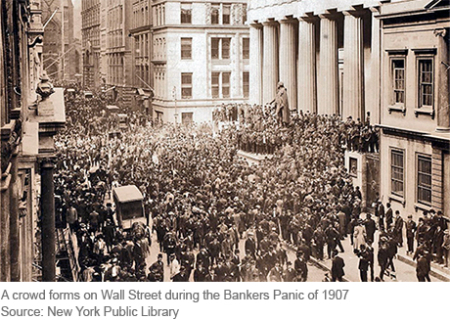Money Market Funds and the New SEC Regulation
Are All CLOs Equal?
Stavros Peristiani and João A.C. Santos Asset securitization is an important source of corporate funding in capital markets. Collateralized loan obligations (CLOs) are securitization structures that allow syndicated bank lenders and bond underwriters to repackage business loans and sell them to investors as securities. CLOs are actively overseen by a collateral manager that has the […]
The Final Crisis Chronicle: The Panic of 1907 and the Birth of the Fed

The panic of 1907 was among the most severe we’ve covered in our series and also the most transformative, as it led to the creation of the Federal Reserve System. Also known as the “Knickerbocker Crisis,” the panic of 1907 shares features with the 2007-08 crisis, including “shadow banks” in the form high-flying, less-regulated trusts operating beyond the safety net of the time, and a pivotal “Lehman moment” when Knickerbocker Trust, the second-largest trust in the country, was allowed to fail after J.P. Morgan refused to save it.
Performance Bonds for Bankers: Taking Aim at Misconduct

Given the long list of problems that have emerged in banks over the past several years, it is time to consider performance bonds for bankers. Performance bonds are used to ensure that appropriate actions are taken by a party when monitoring or enforcement is expensive. A simple example is a security deposit on an apartment rental. The risk of losing the deposit motivates renters to take care of the apartment, relieving the landlord of the need to monitor the premises. Although not quite as simple as a security deposit, performance bonds for bankers could provide more incentive for bankers to take better care of our financial system.
From the Vault: Funds, Flight, and Financial Stability
The money market industry is in the midst of significant change. With the implementation this month of new Securities and Exchange Commission rules designed to make money market funds (MMFs) more resilient to stress, institutional prime and tax-exempt funds must report more accurate prices reflecting the net asset value (NAV) of shares based on market prices for the funds’ asset holdings, rather than promising a fixed NAV of $1 per share. The rules also permit prime funds, which invest in a mixture of corporate debt, certificates of deposit, and repurchase agreements, to impose fees or set limits on investors who redeem shares when market conditions sharply deteriorate. (Funds investing in government securities, which are more stable, are not subject to the new rules.) These changes, driven by a run on MMFs at the height of the financial crisis, add to earlier risk-limiting rules on portfolio holdings.
At the N.Y. Fed: Workshops and New Research on Improving Bank Culture and Governance

The New York Fed takes bank culture and governance seriously. As Bank President William Dudley said at a 2014 workshop convening policymakers and industry participants improving the culture and governance of banks is “an imperative,” both to ensure financial stability and to deepen public trust in our financial system. The Bank built on that first workshop with a second in November 2015 and will host a third event later this month, on October 20.
Could Liquidity Regulation Revive the Bank Lending Channel?

Dong Beom Choi and Ulysses Velasquez How does monetary policy affect spending in the economy? The economic literature suggests two main channels of monetary transmission: the money or interest rate channel and the bank lending channel. The first view focuses on changes in real interest rates resulting from a shift in monetary policy and corresponding […]
At the N.Y. Fed: The Transatlantic Economy: Convergence or Divergence?
On April 18, 2016, the New York Fed hosted a conference on current and future policy directions for the linked economies of Europe and the United States. “The Transatlantic Economy: Convergence or Divergence,” organized jointly with the Centre for Economic Policy Research and the European Commission, brought together U.S. and Europe-based policymakers, regulators, and academics to discuss a series of important issues: Are the economies of the euro area and the United States on a convergent or divergent path? Are financial regulatory reforms making the banking and financial structures more similar? Will this imply a convergence in macroprudential policies? Which instruments do the United States and the euro area have at their disposal to raise investment, spur productivity, and avoid secular stagnation? In this post, we summarize the principal themes and findings of the conference discussion.













 RSS Feed
RSS Feed Follow Liberty Street Economics
Follow Liberty Street Economics